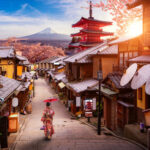Japan Country Foods – If you’re searching for authentic Japanese food outside Tokyo, you’re in for a treat. The countryside of Japan is home to some of the country’s most wholesome and flavorful dishes—many of which never make it into mainstream restaurants or guidebooks. These traditional meals tell stories of the land, the seasons, and centuries-old food culture that still lives on in villages and farming towns today.
Whether you’re a curious foodie or planning your next rural escape, here’s a guide to Japanese village cooking, full of homemade food in Japan’s countryside, local ingredients, and cultural insights.
In Japan, after the main dish is cooked, they sometimes add stuff like minced ginger or strong-smelling herbs on top. These are called tsuma, and they’re kind of like cool extras that make the food look and taste better. It’s not just for flavor though—it makes the dish look more awesome too.
They also use seaweed as a garnish, like crumpled-up nori or these green flakes called aonori. It gives the food more flavor and makes it look cooler. Japanese food is really into making everything look nice and taste great at the same time, even with small things like garnishes.
🏡 What Is Japanese Country Food?
Japan country foods—known as inaka ryori—refer to meals traditionally prepared in rural homes. Unlike the fast-paced food of Tokyo or Osaka, these dishes are simple, seasonal, and deeply connected to the natural surroundings.
Common features of country-style Japanese cuisine:
- Homegrown vegetables and wild mountain herbs (sansai)
- Pickled and fermented sides like miso, tsukemono (pickles), and natto
- Fresh river fish and local tofu
- Hearty rice dishes mixed with grains or beans
- Slow-cooked meals using wood stoves or traditional pots
These meals offer a perfect taste of what locals eat in Japan, especially in farming and mountain communities.
🍲 Best Local Food in Rural Japan
Here are a few must-try dishes when visiting Japan’s countryside:
🥬 Sansai Itame (Stir-Fried Mountain Vegetables)
A healthy mix of wild greens sautéed in soy sauce or sesame oil. You’ll find this dish in most mountain inns and home kitchens.
🍜 Hōtō Nabe (Flat Noodle Stew – Yamanashi Prefecture)
Thick miso broth with chunky udon-style noodles, pumpkin, and seasonal vegetables. Comfort food at its finest.
🍚 Takikomi Gohan (Seasoned Country Rice)
Rice simmered with root vegetables, mushrooms, and soy-based broth. Every region has its own version of this homemade countryside food.
🍡 Gohei Mochi (Nagano & Gifu)
Grilled sticky rice coated with a miso-based sweet sauce—smoky, savory, and satisfying.
🐟 Salt-Grilled Ayu (Sweetfish)
Caught from rivers and grilled on skewers. Served at inns and roadside stalls near rivers or in fishing villages.
🗾 Unique Regional Dishes: Japanese Food Culture by Region
The diversity of Japanese food culture by region is astounding. Here are a few lesser-known, regional specialties worth trying:
- Kiritanpo (Akita) – Grilled mashed rice in hot pot dishes
- Iburigakko (Tohoku) – Smoked and pickled daikon radish, pairs beautifully with sake
- Soba and Konnyaku (Nagano & Gunma) – Regional noodles and jelly-like yam cakes
- Zaru Soba (Nagano) – Cold buckwheat noodles from highland farms
- Miso Dengaku (Nagoya) – Grilled tofu topped with rich miso paste
These dishes show how seasonal Japanese dishes are crafted with local techniques and ingredients, often changing with the weather.
📍 Where to Try Authentic Japanese Food Outside Tokyo
If you’re skipping the big cities and heading into the countryside, here’s where to experience real, authentic Japanese food outside Tokyo:
- Shirakawa-go & Gokayama – Famous for farm-stay meals using mountain vegetables and homemade miso
- Kiso Valley & Tsumago – Enjoy simple, traditional set meals at post-town inns
- Kumamoto & Miyazaki (Kyushu) – Discover hearty rice dishes and fermented foods
- Furano & Biei (Hokkaido) – Try dairy-based dishes and local harvests in farm cafes
- Noto Peninsula – Known for fresh seafood and slow-food traditions
Whether it’s at a farmer homestay, a cozy ryokan inn, or a rural train station café, these regions serve meals that reflect what people really eat in rural Japan.
✨ Final Thoughts on Japanese Village Cooking
If you’re a traveler in search of real, rooted experiences, skip the sushi conveyor belts and instead head for the hills. The best local food in rural Japan is often found where there are no crowds—just farmers, families, and traditions passed through generations.
Japanese village cooking is more than a meal—it’s a story of survival, seasonality, and soul. Each dish celebrates the land, the home, and the joy of sharing something handmade



